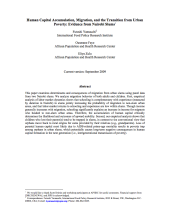Land Library Search
Through our robust search engine, you can search for any item of the over 73,000 highly curated resources in the Land Library.
If you would like to find an overview of what is possible, feel free to peruse the Search Guide.
/ library resources
Showing items 1 through 9 of 13.Producing adequate food to meet global demand by 2050 is widely recognized as a major challenge, particularly for Africa south of the Sahara, including Tanzania (Godfray et al. 2010; Alexandratos and Bruinsma 2012; van Ittersum et al. 2016).
The objective and strategy-oriented development goal of Phnom Penh urbanization aim to:
The form and function of many cities are increasingly marred by congestion, sprawl and socioeconomic segregation, preventing them from experiencing expected productivity gains associated with urbanization.
Can private-sector participation (PSP) in the urban piped water sector improve child
health? The author uses child-level data from 39 African countries during 1986–2010 to show that
introducing PSP decreases diarrhea among urban dwelling children under five years of age by 5.6
This paper examines determinants and consequences of migration from urban slums using panel data from two Nairobi slums. We analyze migration behavior of both adults and children.
This paper explores the diversity of the experience of migrants to rural, peri–urban, and urban areas using a unique longitudinal data set from the Philippines.
The paper examines the possible impact of Doha agreement on Philippine poverty. Using a detailed CGE analysis, the agreement is observed to depress world demand for Philippine agricultural exports, and thus slightly increase poverty, especially among rural households.
"While ample evidence documents that urban children generally have better nutritional status than their rural counterparts, recent research suggests that urban malnutrition is on the rise.
Zambia is one of the poorest countries in Sub-Saharan Africa. Almost three-quarters of the population were considered poor at the start of the 1990s, with a vast majority of these people concentrated in rural and remote areas.




